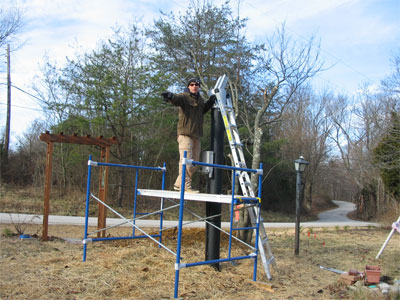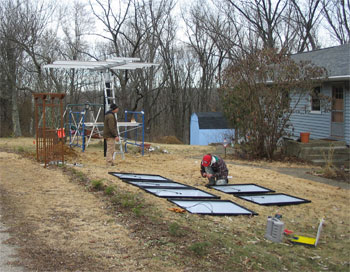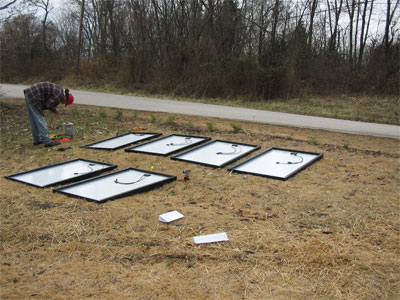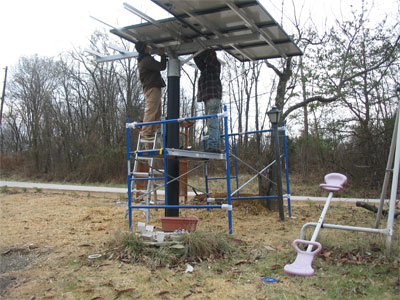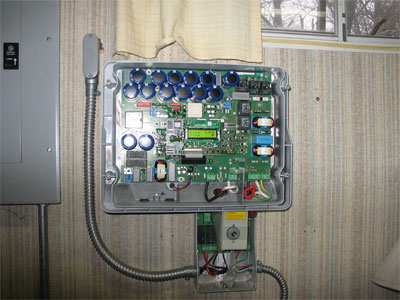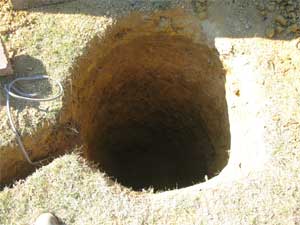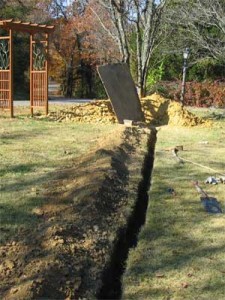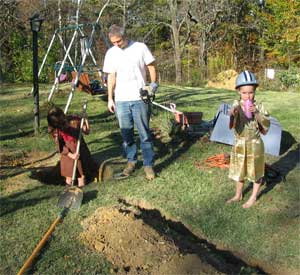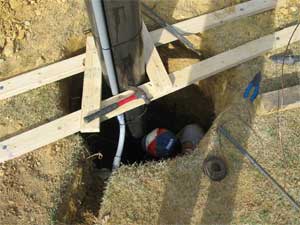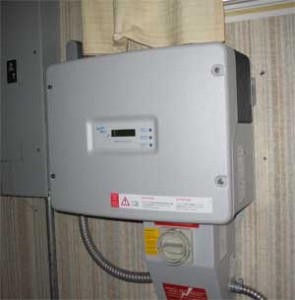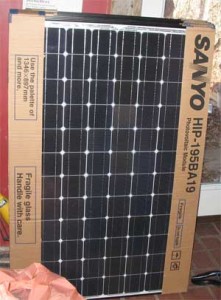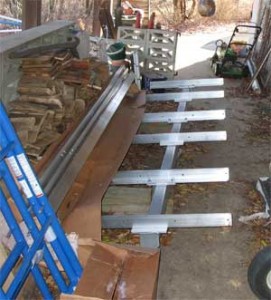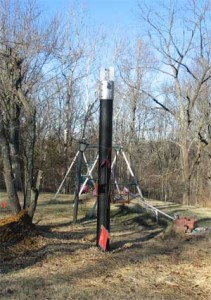Solar Power update (part 8)
 (continued from part 7)
(continued from part 7)
So here we are. February 2010. We had our solar array online for close to a year now.
What are the first year impressions of our life with a 1.2kw solar array in our front yard?
First, if you read the initial installment of my solar power posts you will notice that we built a post with a mount laid out to hold 12 panels. Because 200W panels aren’t cheap we only populated half of the array at first. These six panels were actually only 195W a piece, so to be correct they only add up to 1170w total. Since going online on February 11 2009 we made 1361kwh as of January 31 2010. The array has been producing power for just over 4010 hours. The power output during the course of a nice sunny day starts up around 8:30am (in the winter) with just enough wattage to turn the inverter on, typically 10 watts or so. Around 11:30am, when the sun clears our roof and hits the panels full on we are up to 800 watts which will quickly ramp up to 1050-1150 watts just around noon. It stays there until 2:30pm or so and slowly creeps back down to 50 watts around 5pm. On a sunny, cloudless day this will produce between 4.5 and 5.2kwh. In the summer we get up to 7.5kwh on some days. Of course if we have a very cloudy sky the power never exceeds 50 watts. January around here is like that sometimes. Total electricity usage in our first year with the solar panels was 14,320kwh. That means the panels contributed a little under 10% of the electricity used at our house.
As it turns out my installer, Alex Jarvis from Solar Systems of Indiana, helped me to sign up with a company by the name of Sol Systems which brokers SRECs (Solar Renewable Energy Credits). Based on the size of your system you get a yearly check for offsetting carbon output. I actually did get a check of a couple of hundred dollars for the first year. More than the $85 I saved on my power bills.
One other thing is that my system over-produces sometimes. In other words it makes more power than we use in the house and we get credit for it from our utility company. Unfortunately the credit that we get back is a little more than half of what we pay (we pay $0.0631 per kwh while we only get $0.03357 for a kwh that we feed back in.) Unless we overproduce during peak times – then we get a credit of $6.67 per kwh! During last summer we were actually able to still produce around 500 watts during evening peaks and it turns out it is a good time to turn off everything non-essential in the house for an hour to feed back as much as possible and get the peak time credit. If you can feed back half a kwh on 10 days in a month it adds up to a $40 credit on your power bill – pretty substantial.
Then, on January 5 2010 Alex came over and we added six more panels for a whopping 2370kw. This what our array looks like now:
Why, you ask, would I spend another $4,500 to add six more panels? I mean, I really *only* made about $285 last year. If nothing else happens, nothing changes, the price of electricity stays the same or the days become longer it will take me 33 years to break even, not counting at least one inverter replacement for about $2k in that time – and that calculation does already include a 30% tax break.
The answer isn’t exactly simple.
1) While looking at my power bills, we developed strategies to use electricity when we get it for free from the panels. We learned that dishwasher, washing machine, dryer, computer tasks involving multiple computers, etc. are better done during the day to use power from our solar panels rather than the grid.
2) With the help of a Kill-a-watt, which shows you how much energy a connected appliance draws over a given time, I was able to locate some real energy wasters in the house. For one, the dehumidifier in the basement is now turned off – that things sucks 300-400 watts! That’s about 3000kwh in a year! The solar panels make me really conscious about that stuff.
3) We have about 4-5 months in which we can actually overproduce and feed back power during peak times. With 12 panels we should be able to maximize our credits considerably.
4) While at the moment the 1/2 ratio between what we pay for a regular kwh ($0.0631) and what we get credited for ($0.03357) seems quite unfair, this will change eventually. Even in Indiana the law says utilities are required to pay retail rates for power fed back into the grid. It’s just that our power company is a coop and they are still excluded.
5) While our initial six panels were $1200 a piece and rated at 195w the new ones we put on just three weeks ago where $800 and are rated at 200w. So prices have dropped.
Today was really the first full day of sunlight since we installed the additional panels. Just before shutting down the inverter read 10.41kwh produced. And that’s pretty cool. Considering that on average we use about 39kwh in a day that’s about 1/4 of total electricity from solar. I am sure we will find more holes to plug in the walls and more ways to save energy. It should be an interesting year.



